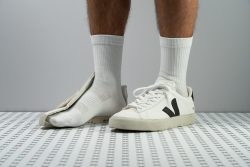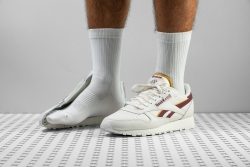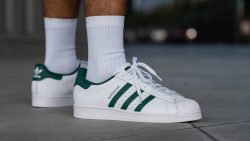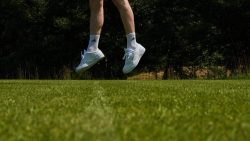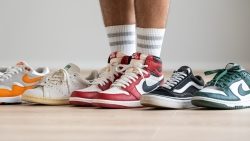7 Best Leather Sneakers in 2025

We buy shoes ourselves. We earn commissions when you buy through us, at no extra cost. Why trust us
If you're on the hunt for sneakers that get even better as you wear them, leather sneakers are your best bet. With so many leather sneakers available, finding the best one without reading hundreds of reviews is not easy.
Whether you're new to the sneaker world or planning to add another leather kick to your collection, we're here to help you out. We have spent hours scrutinizing leather kicks by wearing them daily and testing them in our lab. We showcase several recommendations for you here and dig deep into all the tests and details: how to recognize fake leather, decorative perforations (ventilation holes), leather sneaker breathability, durability, and many others.
How we test leather sneakers
To give you honest and fair reviews, here is our approach:
- We buy the leather sneakers using our own money to stay unbiased. Does not matter how cheap or expensive they are.
- We thoroughly wear-test these sneakers to check their comfort, durability, stability, stiffness, traction, and breathability.
- We do a series of lab tests on them. The most important one for leather sneakers is the leather quality test, where we burn the leather to test whether it's genuine or fake. We don't stop there, so we cut the sneakers in half and measure their stack heights, shock absorption, tongue thickness, and end up with 20+ data points.
- We select the best leather sneakers across different categories based on everything we've experienced in and with the sneakers.
Best leather sneakers overall
























































What makes it the best?
The Adidas Samba OG was made of the real thing, honey! We did the fire test, and the material took all the flames in without breaking or crumbling. Well, yeah, it was discolored, but it remained intact! And the smell of burning hair or flesh was not to be overlooked! Aside from its leather realness, this Adidas sneaker also delivered immense durability and out-of-this-world flexibility, enough for us to crown this as the queen of all leather sneakers.
We subjected both the leather toebox and the padded collar to some serious Dremel drilling. Both displayed so much abrasion resistance. Both areas only looked disheveled at best (or should it be ‘worst’?) when we were done with them. A perfect 5 for durability! Anything lower than that would be illegal!
Just because this shoe showed so much abrasion resistance didn’t mean it would be stiff and unrelenting. Quite on the contrary, this leather sneaker would put Shakira’s hips to shame, honey! It's way more pliable than the typical sneaker. Bending the Adidas Samba OG would require only 8.4N, while the average kick would require as much as 13.1N.
Too bad this shoe wasn’t as breathable as we needed it to be. It only got a disappointing 2 out of 5 in our breathability assessments.
Pros
- Premium-quality and genuine materials
- Long-lasting design
- Lightweight and flexible
- Comfortable for all-day wear
- A lot of ground feel
- Easy to slip-on
- Great all-rounder
- Iconic 90s style
- It has eco-friendly versions
- Worth the price
Cons
- Slightly narrow and tight
- Lacks arch support
- Slippery gum outsole
Leather sneakers with the best traction
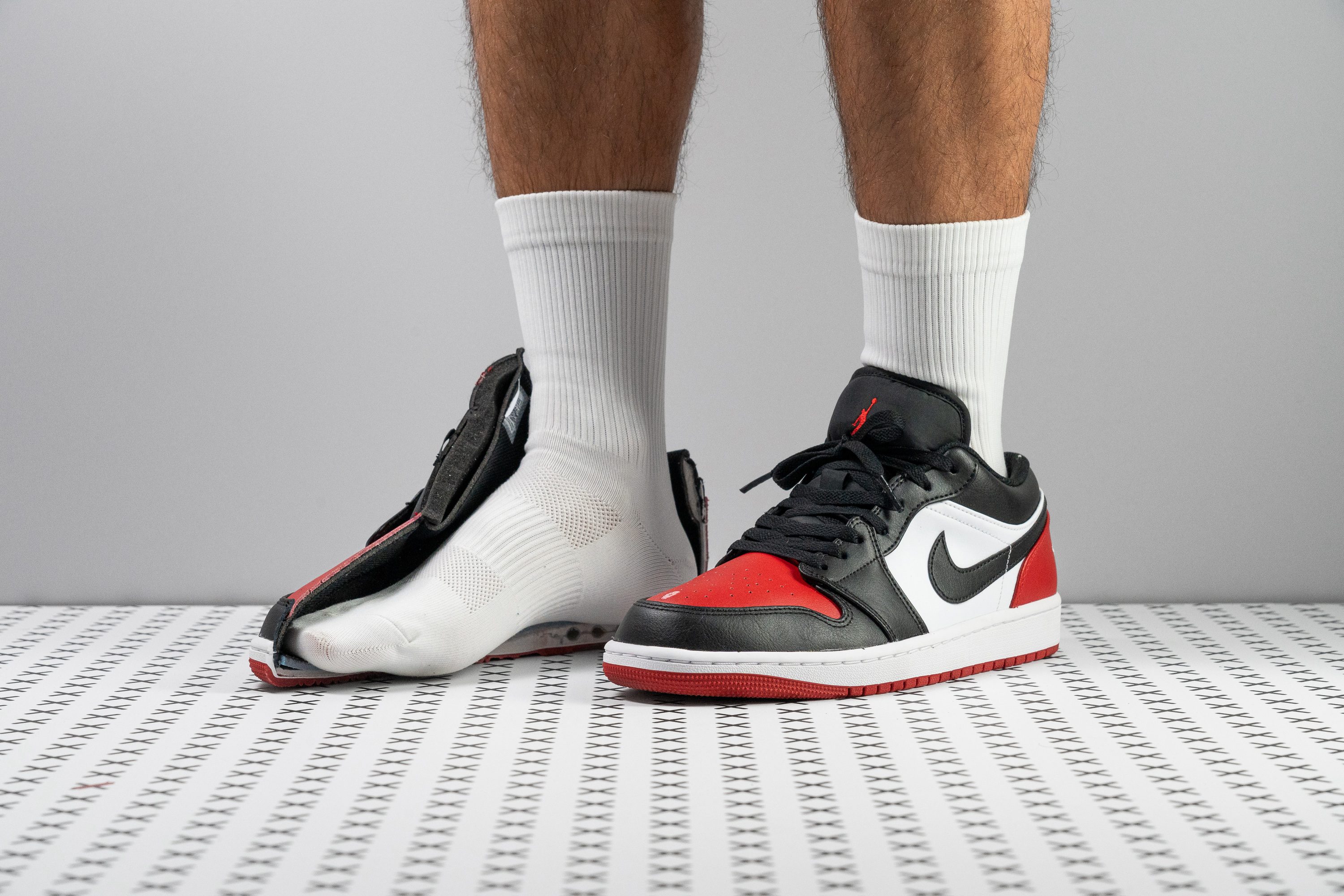

























































What makes it the best?
The Air Jordan 1 Low has a rich heritage, and because of its basketball roots, it offers stability and strong slip-resistance. Among leather sneakers, it shone with the best traction, and our lab numbers speak for it. Proven to be long-lasting, its $125 price is a steal!
For a lifestyle sneaker, AJ 1 Low can handle the slickest surfaces when the need arises, such as snowy sidewalks. In our wet-condition test, it performed with a solid rating of 0.61, making it 45.2% grippier than average.
Besides its firm bite, its low profile enhances a well-planted feeling. Our caliper shows its focus on surface connection with its minimal 22.9/11.8 mm stack height. It’s highly resistant to twisting and excess lateral motions, backed up by its 4/5 torsional rigidity score.
We tested the leather and the outsole using our Dremel, and both results beat the lab average. With its insignificant 0.8 mm dent underfoot, we can expect the shoe to last.
However, the midsole is stiff and requires a break-in period. Those seeking a more natural ride should find more forgiving sneakers.
Pros
- Legendary silhouette
- Adds +1000 points to style
- Fantastic wear resistance
- Very firm and grounded platform
- A Zoom Air unit adds a touch of bounce
- Very secure foothold
- Excellent value for money
- True to size
- Impressive traction on dry and wet
Cons
- Leather creases easily
- Takes a while to break in
- Not for all-day wear
Best retro leather sneakers
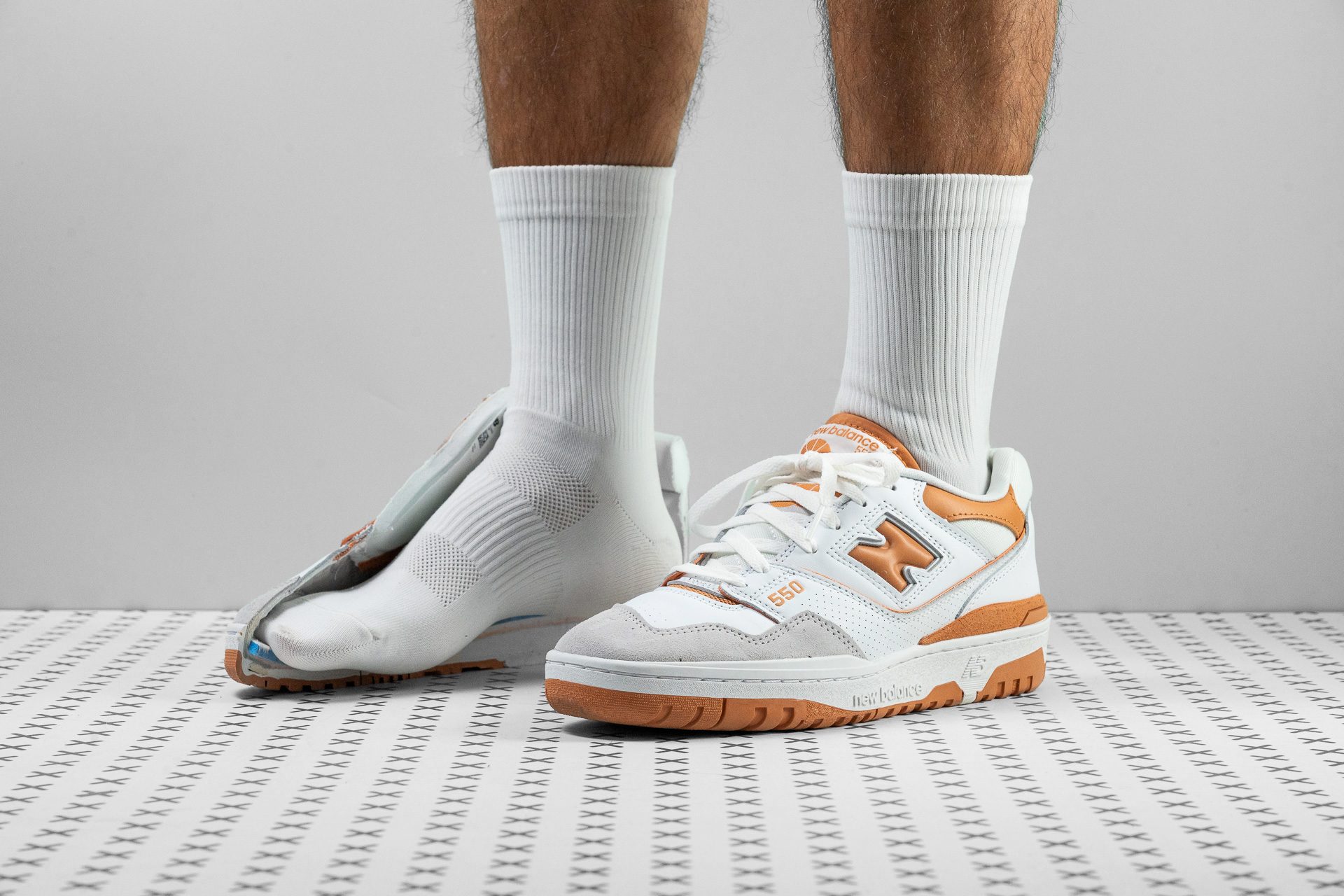












































What makes it the best?
Significant portions of the New Balance 550’s upper were made of real leather, and we couldn’t be more excited about that! Aside from providing durability and structure, the leather made this shoe such a pleasure to see. It retained much of the attributes of the OG 550 so our retro-loving hearts flutter. We also loved that the shoe had an unusually thick insole for dependable arch support. The best retro leather sneaker, indeed!
We torched the overlays on the upper, and then removed the charred surfaces with our awl. We saw that it did not really burn, leading to conclude the genuineness of the leather used.
The leather became soft and flexible over time, but it never lost its durability. Our Dremel was only able to smoothen out the velvety overlay on the toe box, but it never got to cause real damage. The 4 over 5 score that we gave was truly well-deserved.
Based on our caliper readings, the insole was 8.8 mm thick. The insole used in the NB 550 was a lot thicker than average, which was recorded to be only 5.4 mm thick. In addition to providing underfoot pampering, this soft insert also delivered arch support.
Wide-footers, however, couldn’t enjoy this shoe. The toebox was just too narrow for them. At the big toe, this shoe was only 71.2 mm wide. The average width of this part was 75.2 mm.
Pros
- Attention-grabbing throwback look
- Incredibly clean details
- Suitable for various outfits
- Durable, high-quality construction
- No visible wear after several uses
- Easy to clean
- Striking shades
- Reasonably priced
- Awesome grip on wet and dry streets
Cons
- Firm and dull platform
- Insufficient lockdown feel
Best lightweight leather sneakers








































What makes it the best?
The Reebok Classic Leather delivered an amazingly reliable heel hold. Aside from that, it also provided us with a thicker-than-average midsole that was effective in neutralizing impact. Still, this shoe still managed to keep its weight low and nice. Having been able to make the most out of every ounce of its weight, we hail the Reebok Classic Leather as the best lightweight leather sneaker in our inventory.
In our lab, we gave the heel counter a good squeeze to test its ability to provide much needed support and responsiveness. It passed with flying colors, garnering a score of 4 out of 5 from us. True enough, it was able to hold its own even when our movements became a bit more aggressive than usual.
Based on our caliper measurements, the midsole of the Reebok Classic Leather was on the thicker side. At the forefoot, it was 22.1 mm (ave 20.0 mm) thick. Its heel stack was as high as 35.7 mm (ave 31.3 mm). The thick midsole not only provided impact protection, it also made us feel and look taller.
What amazed us the most was the shoe’s weight. It still managed to be light at 11.39 ounces (323 grams) while providing all the goodness that we just described. The average weight for sneakers was 14.04 oz or 398 grams. This was such a feat!
We just wish this sneaker were a bit more breathable. It only got a disappointing 2 out of 5 in our breathability assessments.
Pros
- Mighty plush
- Great investment
- Leader of the pack
- Supportive
- Aesthetically well-rounded
- Enduring
- Affordable
Cons
- Downgraded upper
- Dirt-magnet
Leather sneakers with the best shock absorption
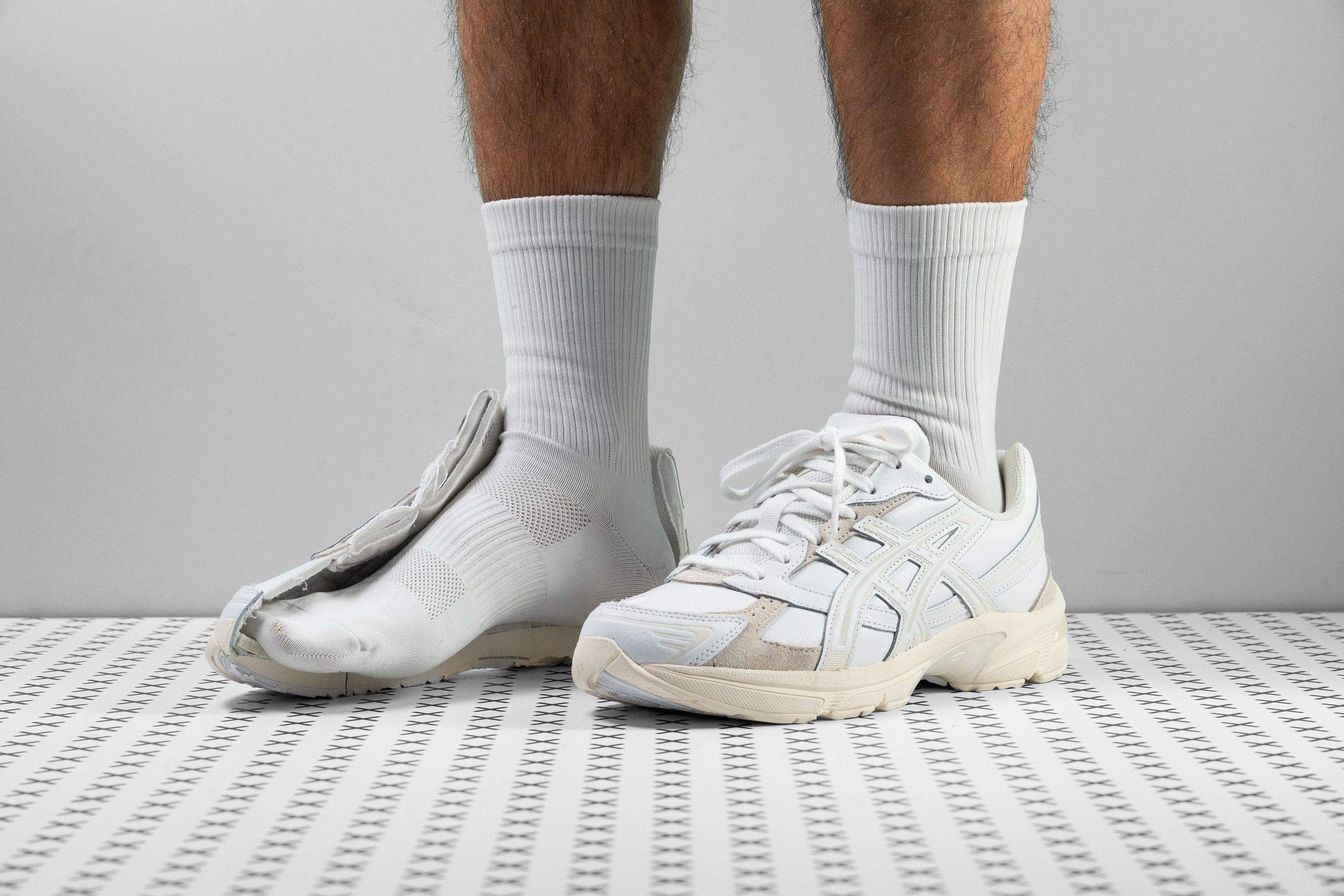
























































What makes it the best?
As a running shoe in its past life, the ASICS Gel 1130 offers a light, well-cushioned, and supportive experience. It feels good to be in for long hours and features technologies like the Gel cushioning and the TRUSSTIC system, as we confirmed in the lab. Among leather sneakers, it takes the win for shock absorption.
The Gel technology is positioned in two key areas: the heel for gentler landings and the forefoot for enhanced cushioning. Our feet rested atop the comfortable platform, which helped us stay on foot for hours without any pain. In our shock absorption test, we recorded a high score of 114 SA, solidifying its joint protection.
We put our full confidence and trust in the sneaker’s TRUSSTIC support system, which keeps us centered and well-planted. It delivers a strong foothold that makes it almost impossible to lose our balance.
What’s amazing is how Gel 1130 offers all these and more in its minimal 12.9 oz (366g) package, which helps prevent fatigue.
However, we wrestled with the shoe quite a bit because of its stiff midsole. Those who want more fluidity in each step should try searching for more flexible sneakers.
Pros
- Comfortable for all-day wear
- Stable platform
- Top-notch materials
- Excellent craftsmanship
- Supportive foothold
- Grippy, running-inspired outsole
- Feels lightweight with a padded interior
- Roomy at the big toe
- Real suede and leather
- Cool 90s dad shoes retro vibe
Cons
- The leather version lacks breathability
- Quite stiff
Leather sneakers with the best style
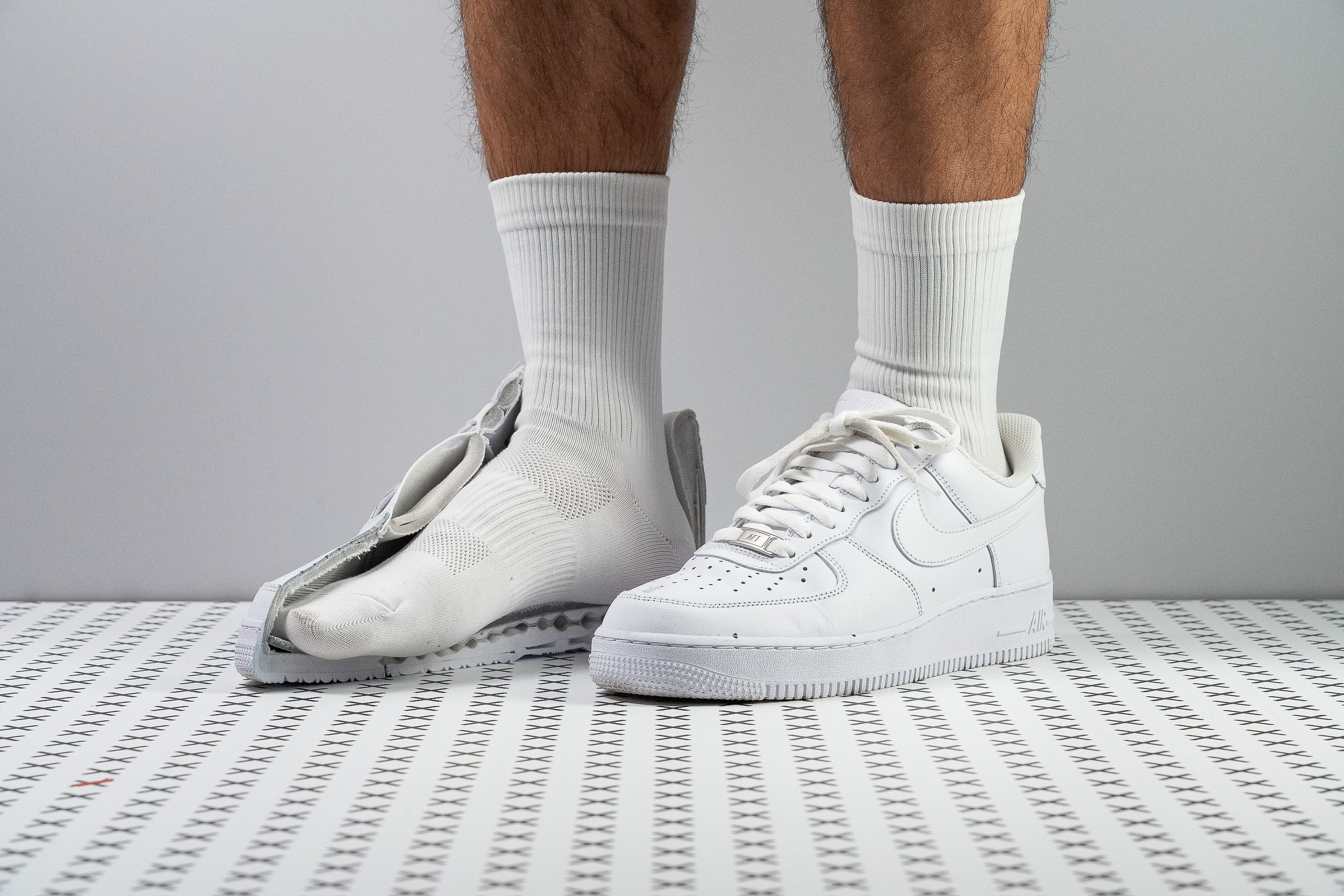





















































What makes it the best?
With its legendary roots and crisp and clean all-leather profile, Nike’s Air Force 1 07 is effortlessly classy. Its iconic silhouette has transitioned seamlessly from the basketball courts to the streets and runways with its versatile appeal. Plus, its sturdy construction delivers stability and durability. Since its release in the 80s, it hasn’t gone out of trend, making it our most stylish leather sneaker in the lab.
The leather upper not only exudes style but also offers excellent protection. Our torch test confirmed its genuineness as the major panels didn’t melt away. Meanwhile, the toebox fought our Dremel persistently, earning a 5/5 durability rating.
Structured and rigid, the midsole holds us firmly in place. We found it difficult to pinch the heel and twist the shoe, maxing out the stiffness score in our manual assessments. Proving its unwavering nature, it even emerged 40.7% stiffer than average in our bend test.
The hard-shell construction and moderate stack enhanced our balance. The platform includes an Air Max unit within a soft 20.9 HA foam to add cushioning. However, these elements are inside a solid construction, leading to a firm and steady ride.
However, the shoe feels like a brick with its stiffness and heavy weight. Those who prioritize comfort over fashion should look elsewhere.
Pros
- Crisp and classic look
- Can be dressed up or down
- Great leather quality for the price
- Responsive Air cushioning
- Highly stable and supportive
- Decent airflow for a leather shoe
- Reasonably priced
- Can last for years
- Good outsole traction
Cons
- Quite heavy
- Creases easily
- Not for all-day wear
- Arduous break-in period
3 things you must know about leather labeling
When looking for leather sneakers, you may want to know whether the leather is real or high-quality. The trouble is, without expertise and, often, cutting the leather, it’s impossible to tell, and here’s why:
- Genuine does not mean high quality. The term was so overused that now it is mostly used for very low-quality materials that may have only a hint of leather, and the rest is PU (polyurethane). What makes things even worse is that there are no legal ramifications for this, so producers can write “genuine” even when it’s mostly filler and get away with it.
- Top grain is not the best of the best. It depends on the tannery and who makes the leather. There is suede from one tannery that is of better quality than “top grain” from another tannery. And, it depends on your taste and how you want the leather to look and feel. Not everything you want is possible in a top-grain or full-grain variant.
- It can be a mixed bag, and, in common sneakers, it often is. This means that a small part can be made of leather, often of low quality, while the rest is PU covered with a layer that looks like leather, or a similar combination of non-leather materials.
If there’s one takeaway about leather, it’s this one above. OK, there are 3 points.
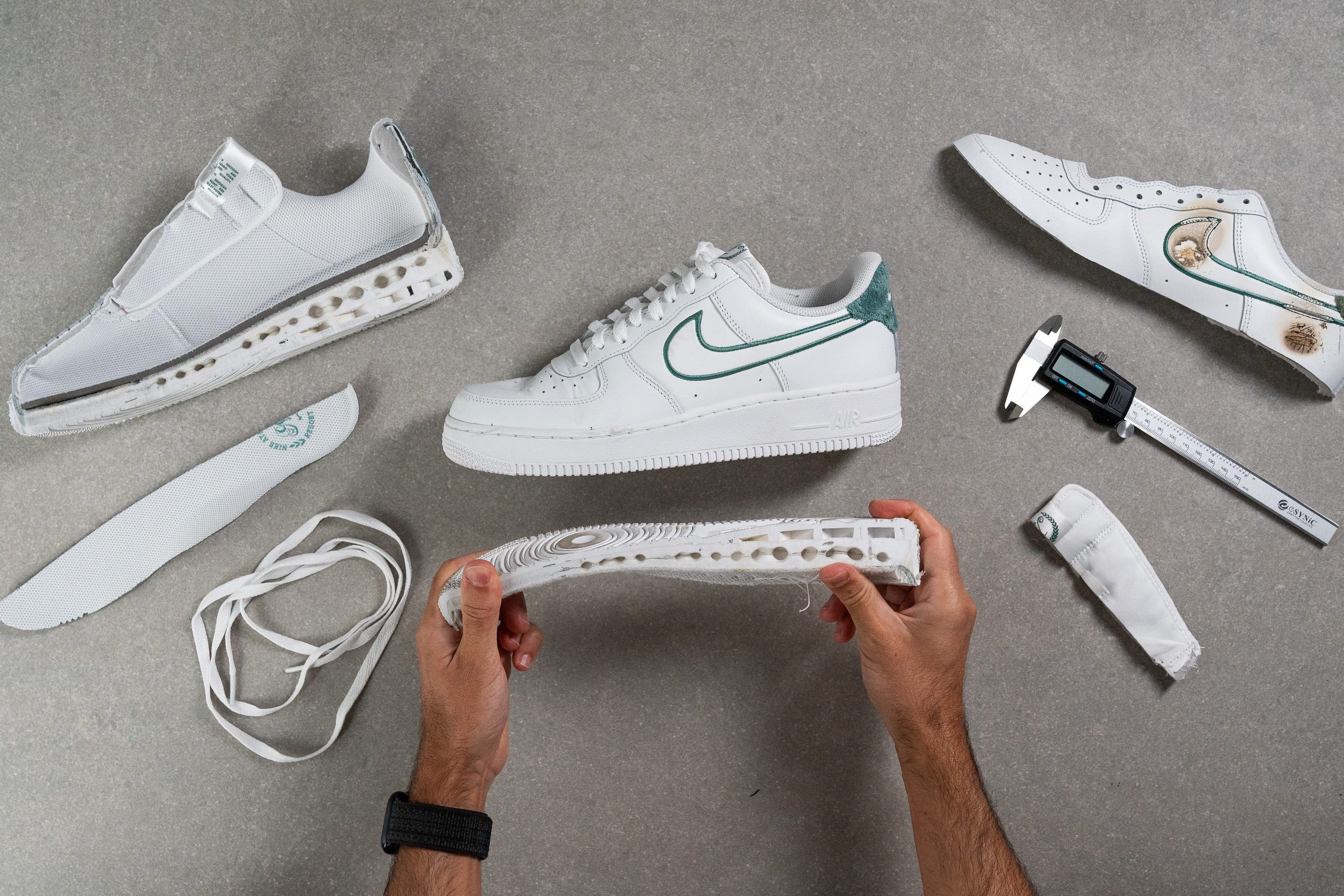
THE question: Is the leather REAL?
There are 4 criteria we stick to when deciding whether we will write REAL or FAKE in our lab reviews. Learn more about them below.
1 The smell
When burning the leather, if it smells like burnt hair, it’s real. If it smells like melted plastic, it’s fake.
2 The look when burned
When burning the leather, fake leather bursts into flames, melts, and becomes sticky.
Burning the fake leather
Real leather, on the other hand, chars and we can scratch it with an awl to discover other leather layers.
Burning the real leather
3 The look when cut
When we cut the leather and look at the raw edge, if it’s grainy or has noticeable leather threads pointing in different directions, it’s real. Real leather does not have visible layers; it is dense. If it’s foamy or has a noticeable leather-like overlay that covers polyurethane, it’s fake.
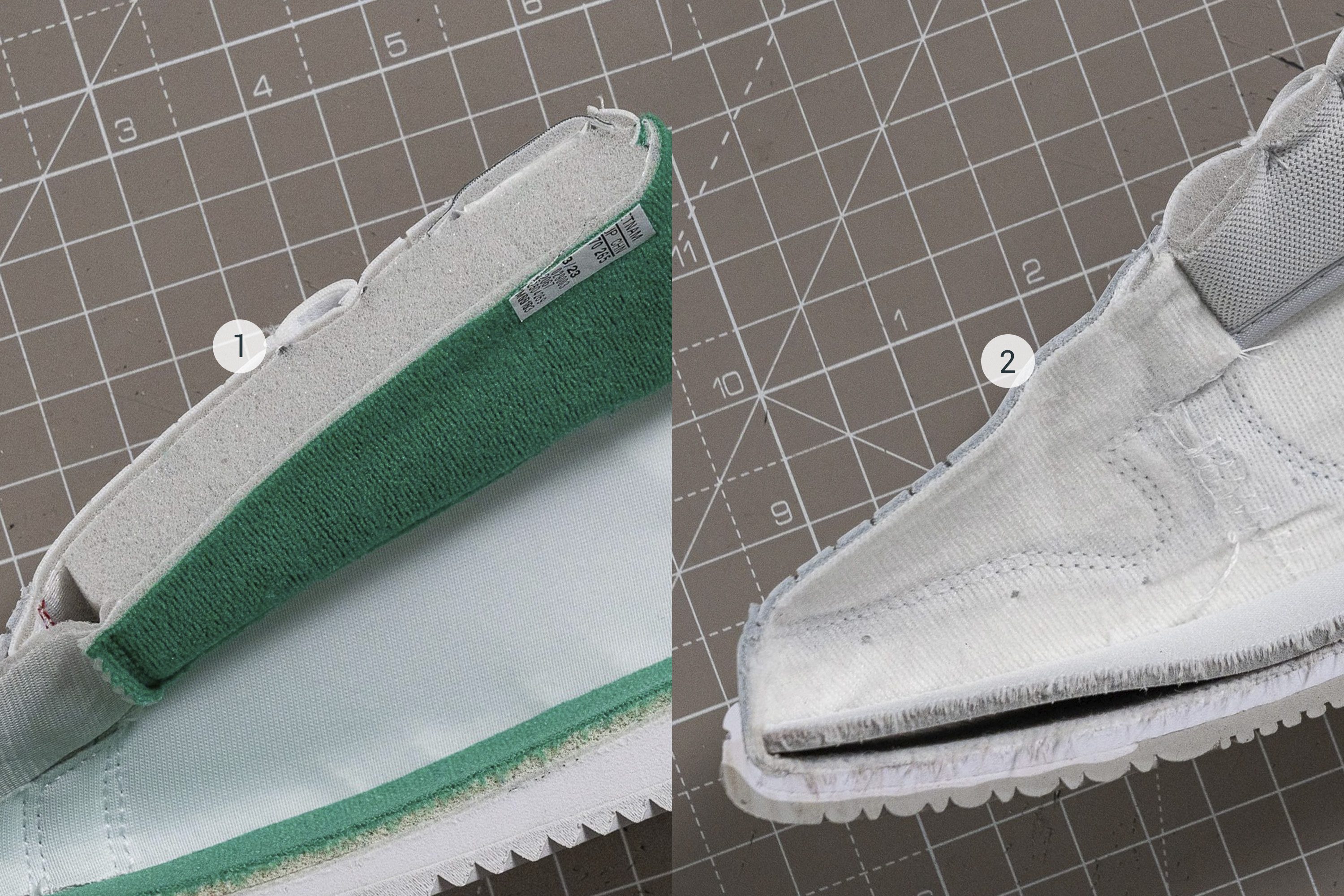
Many people complained once brands started using a very thin layer of full-grain leather, which was glued onto the polyurethane and then sealed on the sides with it as well. This made it impossible to figure out what’s happening. Enters RunRepeat lab team. We cut the shoe in half and look into all the layers and details.
4 Percentage of real/fake leather
For us to tag a sneaker as real leather or fake leather, the majority of the upper has to be real leather or fake leather, respectively.

2) and 3) real suede, 4) mesh
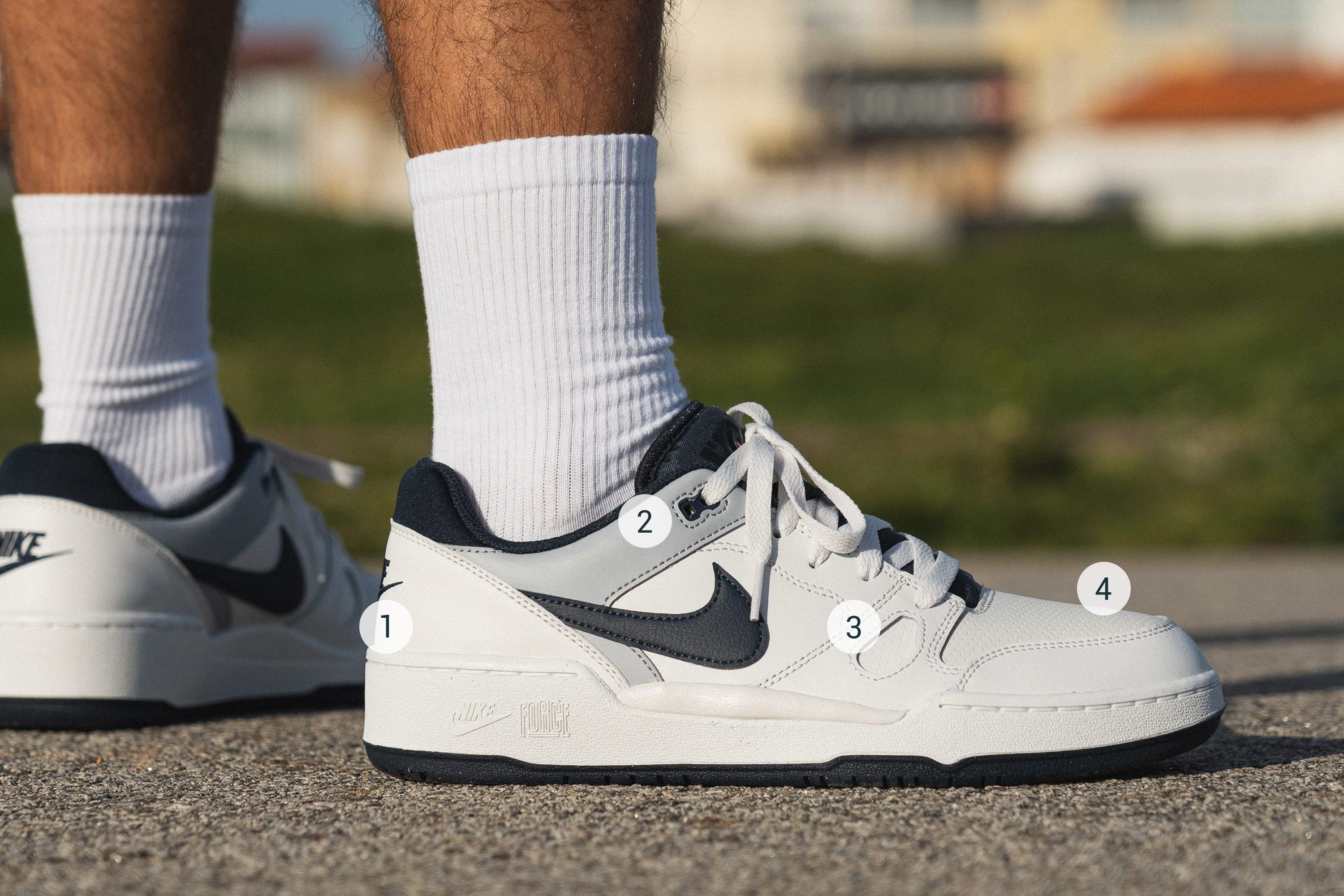
3) and 4) real leather
This means that if only a logo is made of leather lookalike, while the rest is real leather, we will tag it as Real leather.
Breathability of leather sneakers
Breathability depends on the upper material and whether there are ventilation holes in it. This would be much simpler if it were the end of the story; however, throughout our testing, we realized that some sneakers feature decorative ventilation holes only.
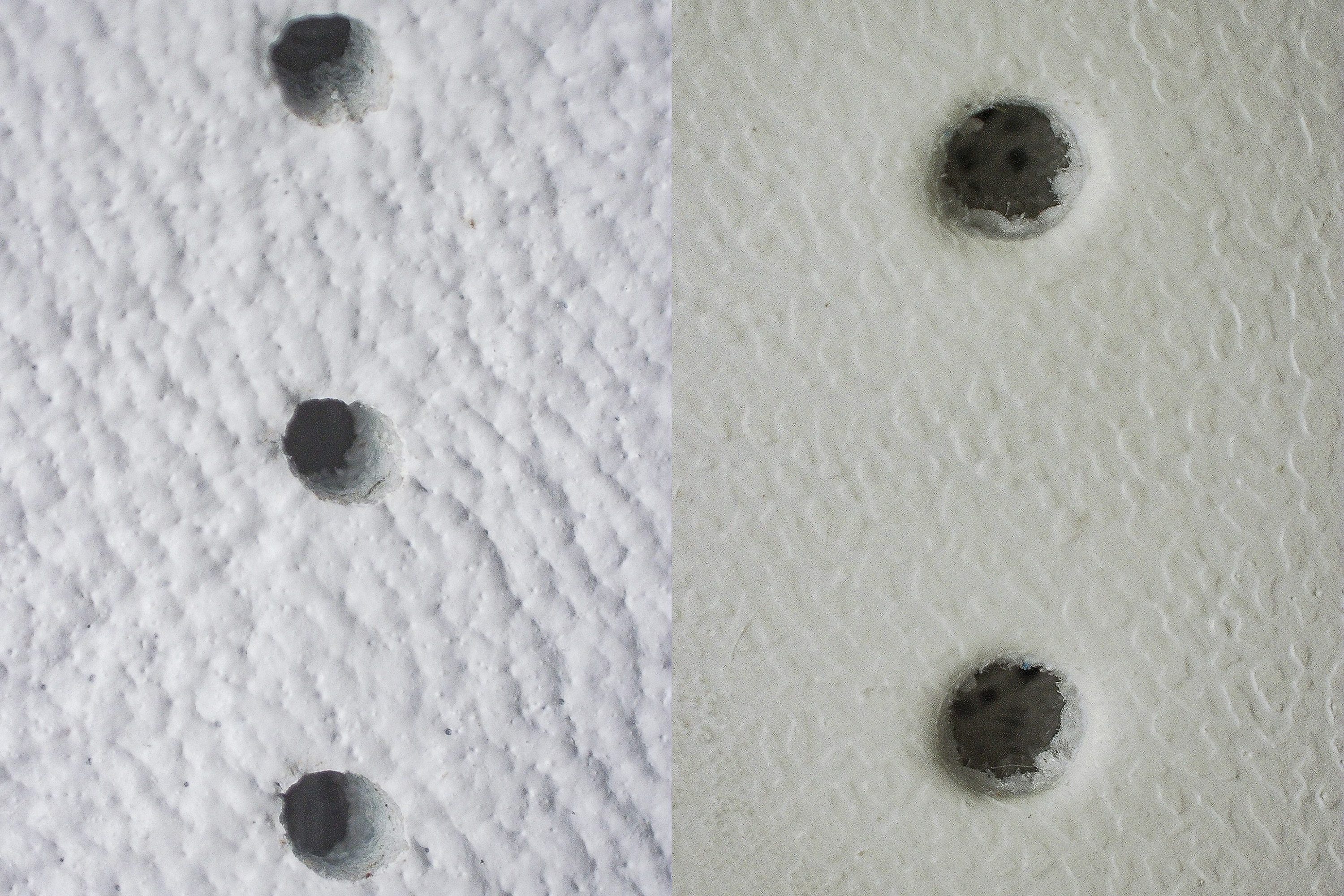
Leather on its own is not breathable when compared to mesh. However, it is still a natural material, and it’s usually not the worst even for warmer days. That’s why we often see people wearing Blundstones or similar leather footwear even in hot weather.
|
It’s important to note that some leather sneakers still have a mesh toebox. This, of course, significantly impacts the breathability test result. If the majority of the upper is still made of leather, we list them under leather sneakers. |
To test breathability, we fill the sneaker’s toebox with smoke using a smoke machine and then watch where the smoke comes out and at what pace. Based on what we see, we assign a 1-5 breathability rating to each sneaker. 5/5 is used only for the most breathable sneakers out there!
Then we look at the upper under a microscope. This is very useful when we’re analyzing knit and mesh because we get to see different layers, ventilation holes that are not visible to the naked eye, weird material and color combinations, and so on.

When it comes to the leather, it helps us determine whether the ventilation hole is real or not.

Durability of leather sneakers
The durability varies because the materials vary. As established above, there isn’t only one type of leather used in sneakers. And, some sneakers are made of leather with the exception of the toebox, which may be mesh. So, we’re seeing different results when doing durability tests in our lab.
To test the toebox, we press a Dremel against it and then look at the damage. The deeper the hole, the worse the durability.

We also test the durability of the heel padding and the outsole.
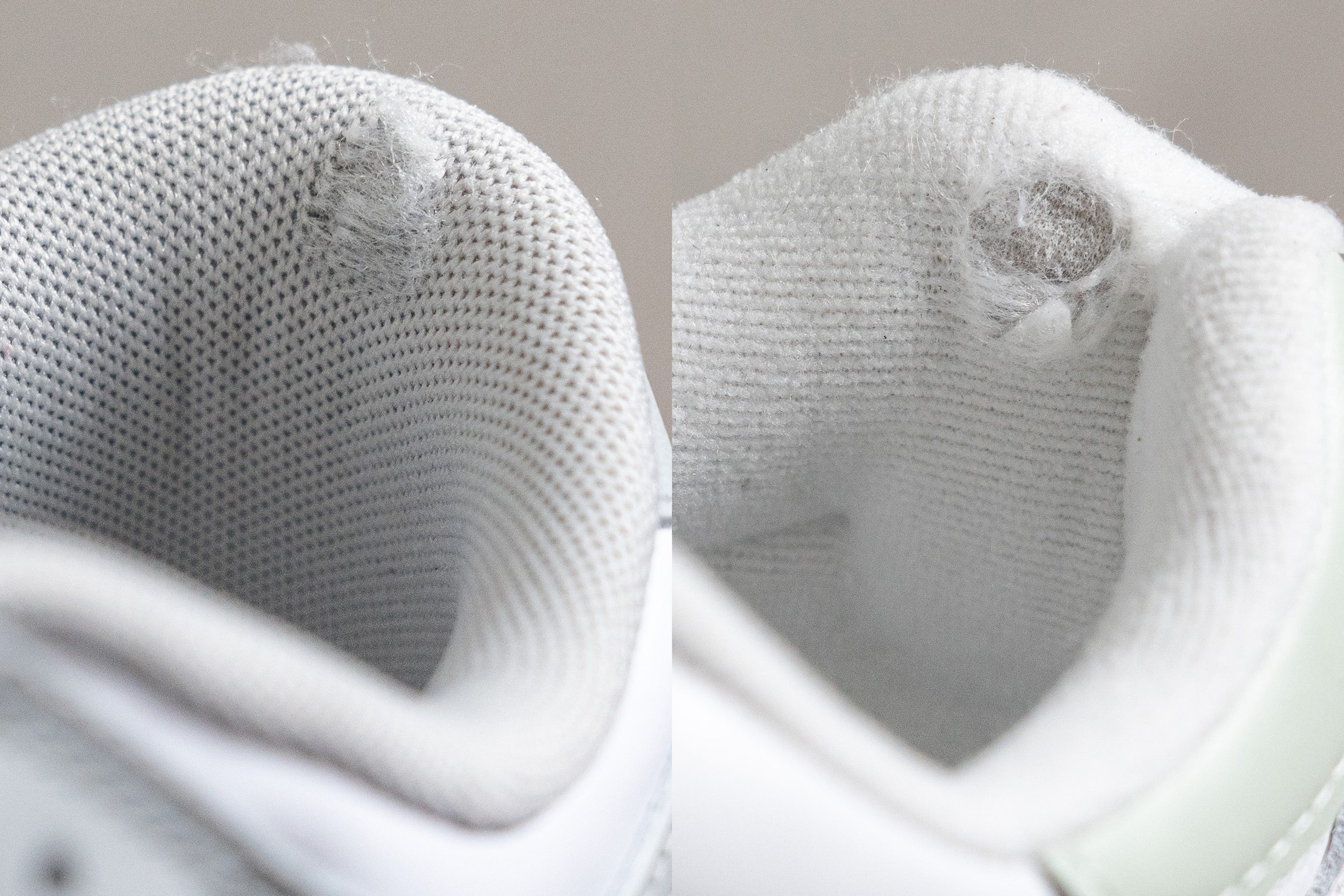
We perfom this Dremel test on the sneaker outsole as well, only now we don’t have to assess the damage, but use a tire tread depth gauge to precisely measure the depth of the dent.
Cheapest leather sneakers
The better the leather, the higher the price. It’s as simple as that because high-quality leather costs (a lot). However, sneakers often have a mix of materials of different qualities. Premium leather sneakers are excluded as we haven’t tested those yet!

Here, you can see the cheapest leather sneakers at the moment of their release (which is why we list their MSRP or manufacturer’s suggested retail prices):
However, sneakers are often discounted. There are a few things you can do to find a good deal: 1. Visit the sneakers deal page where we showcase the biggest discounts, 2. Subscribe to our price alerts and get an email when the price drops, 3. Look at the price history and learn more about previous discounts and which prices you can expect.
Pros of wearing leather sneakers
In case you’re not convinced yet or you need a confirmation that the decision to buy leather sneakers is a good one, here’s why it’s good to wear leather sneakers:
- Leather sneakers are more durable than canvas or mesh sneakers. They are more difficult to rip or tear
- Durability also makes leather more protective for your feet. It’s not like you plan to hike over trails covered in sharp debris, but the protection can come in handy
- Leather is great for different weather conditions. It’s naturally waterproof to a certain degree, and you can use special sprays to maintain that waterproofness
- Leather is easy to maintain, and different stains are easily removed (wiped away), unlike canvas, which soaks them in and you may struggle removing the stains entirely

Who should NOT buy leather sneakers
Leather, like any other material, has a few downsides:
- Breathability is usually dependent on the ventilation holes. Some sneakers have them, others don’t. And even those that do have them… might have fake ventilation holes. In our reviews, we always double-check.
- Leather creases. It’s a normal thing, but many don’t like how it looks.
- Leather sneakers are heavier than canvas/mesh ones.
- Leather sneakers may be more expensive than canvas/mesh ones, but this may not be justified, given that many sneakers feature materials with traces of leather only, or not even that.
- Vegans and vegetarians often choose eco-friendly alternatives to leather. Animal cruelty is still an important topic, and although there are manufacturers who claim they got the leather from animals that were killed for different purposes, the whole process is still something many can’t just turn their heads from.
- The environmental impact is significant. Water use, carbon emissions, toxic chemicals, and biodegradability–when all of these puzzle pieces are taken into account, those who care about this planet and their ecological footprint usually look for alternatives.

Short leather glossary
If you ran into a few unknown words in this guide or you want to do more research, here are the terms you should be familiar with.
Hide is the natural, non-treated skin of an animal.
Tanning is a process that turns animal skin into leather that can be used to make different goods like jackets, bags, footwear, belts, etc.
Geniuine leather is a term used for all sorts of leather and, unfortunately, thanks to its overuse, it is usually used for low-quality leather. The bar for leather to be called genuine is very low.
Top grain is the top part of the leather if you look at its raw cut. It’s the part that hasn’t been altered. It may feature blemishes, pores, scars, and similar marks.
Full grain comes after the top grain, looking at the vertical cut of the leather, but it may include the top grain. Full grain usually means the leather has been sanded. This type of leather is often treated so it may have a different finish, like waxy or glossy.
Splits or split leather is the bottom part of the hide. From top to bottom: top grain, full grain, the splits. It does not include the grain part at all, so it is less durable, of lower quality, and often used in budget products.
Nubuck is a soft and fuzzy sanded top-grain leather. It is very resilient, so it’s often found on the interior of shoes and watches. While it is similar in looks and feel to suede, it is made from the outer side of the hide.
Suede is soft to the touch and similar to nubuck, but it’s made from the underside of the hide. This makes it less durable than nubuck because it’s made from more flexible (and less dense) hide layers.
Bonded leather is made of leftover leather scraps and pieces glued together with a binding agent, such as polyurethane or latex. Once this mixture is ready in the form of a sheet, it is stamped with a leather-grain pattern. Bonded leather contains a very low percentage of leather pieces (less than 20%), which is why it is often considered fake leather.




